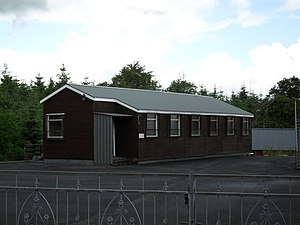This is an old revision of this page, as edited by Asarlaí (talk | contribs) at 18:11, 10 January 2013. The present address (URL) is a permanent link to this revision, which may differ significantly from the current revision.
Revision as of 18:11, 10 January 2013 by Asarlaí (talk | contribs)(diff) ← Previous revision | Latest revision (diff) | Newer revision → (diff)The name Catholic Reaction Force (CRF) was used in Northern Ireland to claim responsibility for attacks and threats against Protestants during The Troubles. In 1983 it was used to claim responsibility for the shooting dead of three Protestant civilians at a church service near Darkley, County Armagh. That was claimed as retaliation for attacks on Catholic civilians. An Irish National Liberation Army (INLA) member was involved, but the INLA said it had not ordered the attack.
Darkley killings

The name was first used to claim responsibility for a shooting on 20 November 1983. That night, two masked men opened-fire outside Mountain Lodge Pentecostal Church near Darkley, County Armagh. A church service was taking place at the time. Three Protestant civilians were shot dead at the entrance: Harold Brown (59), David Wilson (44) and Victor Cunningham (39). The gunmen then sprayed the church with bullets, wounding seven people.
A telephone caller claimed responsibility on behalf of the "Catholic Reaction Force". He said it was
...in retaliation for the murderous sectarian campaign carried out by the Protestant Action Force … by this token retaliation we could easily have taken the lives of at least 20 more innocent Protestants. We serve notice on the PAF to call an immediate halt to their vicious indiscriminate campaign against innocent Catholics, or we will make the Darkley killings look like a picnic.
The caller named nine Catholics who had been attacked or killed recently.
A week after, Irish National Liberation Army (INLA) leader Dominic McGlinchey gave an interview. He admitted that one of the gunmen had been an INLA member and admitted supplying him with the gun. The INLA member's brother had been killed by loyalists. McGlinchey explained that the INLA member asked him for a gun to shoot a known loyalist who'd been involved in sectarian killings. However, "clearly deranged by the death of his brother", he "used it instead to attack the Darkley Gospel Hall". McGlinchey said: "this INLA member was a brother of someone who had been killed…and he must have been unbalanced or something to have gone and organised this killing. We are conducting an enquiry into the whole affair".
The CRF declared a ceasefire on 28 October 1994.
Other claims
The name was used to claim another two attacks on 20 August 2001. In one, shots were fired at a house in Cloughmills and in the other a pipe bomb was thrown at a Protestant home in Ballymena.
In August 2002, a death threat was sent in the name of the CRF. It warned that the CRF would kill three unnamed Protestants who worked at hospitals in Belfast and who had links to the security forces. Soon after, loyalists threatened to kill Catholics working at two Belfast hospitals. Gerry Kelly and Sue Ramsey of Sinn Féin said they believed the CRF threat was sent by loyalists to raise sectarian tension. Kelly added: "The Catholic Reaction Force is a non-existent organisation".
See also
References
- http://cain.ulst.ac.uk/cgi-bin/dyndeaths.pl?querytype=date&day=20&month=11&year=1983
- CAIN - Chronology of the Conflict - November 1983
- McKittrick, David. Lost Lives. Mainstream Publishing, 2001. p.963
- ^ Ireland's Terrorist Dilemma. Martinus Nijhoff Publishers, 1986. pp.104-105
- Coogan, Tim. The IRA. Palgrave Macmillan, 2002. pp.535-536
- http://www.uhb.fr/langues/cei/chron94.htm
- http://www.start.umd.edu/gtd/search/IncidentSummary.aspx?gtdid=200108200012
- http://archives.tcm.ie/breakingnews/2002/08/05/story62792.asp
- http://www.cnn.com/2002/WORLD/europe/08/06/belfast.hospitals/